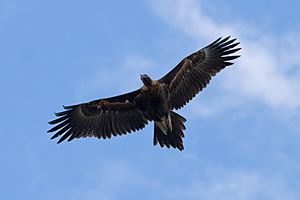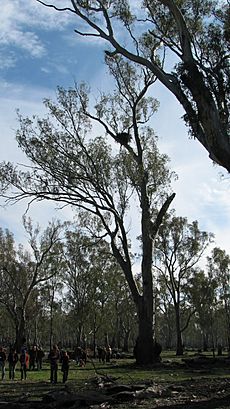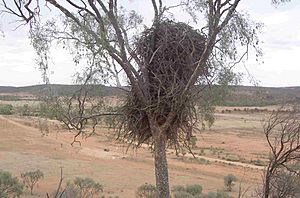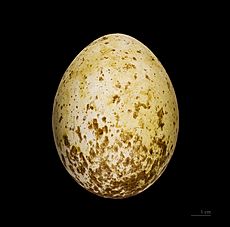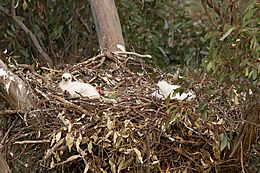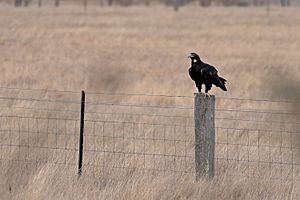Wedge-tailed eagle facts for kids
Quick facts for kids Wedge-tailed eagle |
|
|---|---|
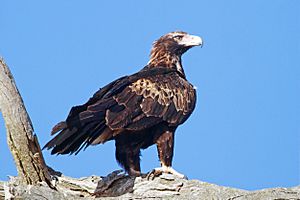 |
|
| Conservation status | |
| Scientific classification | |
| Genus: |
Aquila
|
| Species: |
audax
|
 |
|
| Range of A. audax Resident | |
The wedge-tailed eagle (Aquila audax) is the biggest bird of prey in Australia. You can also find it in southern New Guinea. This amazing bird has long, wide wings and legs covered in feathers. Its tail is shaped like a wedge, which makes it easy to spot!
This eagle is one of 12 large, dark-colored eagles in the Aquila family. It is a big brown bird. Its wings can spread up to 2.84 m (9 ft 4 in) wide. The eagle itself can be up to 1.06 m (3 ft 6 in) long.
Contents
About the Wedge-Tailed Eagle
Naming and Types
The wedge-tailed eagle was first described by an English bird expert named John Latham. He named it Vultur audax in 1801.
There are two main types, or subspecies, of this eagle:
- A. a. audax (Latham, 1801) – This type lives in Australia and southern New Guinea.
- A. a. fleayi Condon & Amadon, 1954 – This type lives only in Tasmania.
What Does It Look Like?
Female wedge-tailed eagles are bigger than males. Females weigh between 3.0 and 5.8 kg (6.6 and 12.8 lb). Males weigh 2 to 4 kg (4.4 to 8.8 lb). These eagles are between 81 and 106 cm (32 and 42 in) long. Their wingspan is usually between 182 and 232 cm (6 ft 0 in and 7 ft 7 in).
This eagle is one of the largest eagles in the world. Its wings are very long, over 65 cm (26 in). Its tail is also long, about 45 cm (18 in).
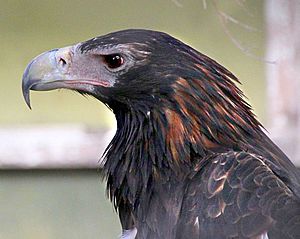
Young eagles are a medium brown color. Their wings and head are a bit lighter and reddish-brown. As they get older, their feathers become darker. After about 10 years, they are a very dark blackish-brown. Eagles in Tasmania are often darker than those on the mainland. Adult females are usually a little lighter than males.
The wedge-shaped tail is special to this eagle. It helps tell it apart from other eagles. Sometimes, it can look a bit like the white-bellied sea eagle. Both are similar in size and shape. However, the wedge-tailed eagle's tail is much bigger and more unique.
Where They Live and How They Reproduce
Habitat
Wedge-tailed eagles live all over Australia, including Tasmania. They are also found in southern New Guinea. They can live in almost any environment. They are most common in open areas with some trees in southern and eastern Australia. These eagles are also found in Australia's deserts. But they are rare in the driest parts, like the Lake Eyre basin. In New Guinea, they live in the Trans-Fly savanna and grasslands.
Life Cycle
When it's time to breed, eagle pairs sit close together. They preen each other's feathers. They also do amazing flying displays high above their home area. The male might dive very fast towards his partner. As he pulls up, she might ignore him or turn upside down. She stretches out her talons. Then, they might even do a loop-the-loop!
Wedge-tailed eagles usually build their nests in a tree fork. Nests are usually between one and 30 meters above the ground. If there are no good trees, they will nest on a cliff edge.
Before the female lays eggs, both eagles build a large stick nest. Or they add new sticks and leaves to an old nest. Nests can be 2 to 5 meters deep and wide. The female usually lays two eggs. Both parents take turns sitting on the eggs to keep them warm. This takes about 45 days.
When the chicks hatch, the male eagle does all the hunting at first. When the chicks are about 30 days old, the female stops sitting on them. She joins the male to hunt for food. Young eagles rely on their parents for food for up to six months after hatching. They only leave when the next breeding season begins.
Behavior and Diet
Soaring and Hunting
Wedge-tailed eagles love to fly high in the sky. They can soar for hours without flapping their wings. They often reach 1,800 m (5,900 ft) high, sometimes even higher! Their eyesight is very sharp. They can even see ultraviolet light.
Most of their food is caught on the ground. They glide down to attack their prey. Sometimes, they catch prey in the air. They eat what is easiest to find. Since Europeans arrived, rabbits and brown hares have become a main part of their diet. They also sometimes eat larger animals like foxes and feral cats.
Native Australian animals they hunt include wallabies, small kangaroos, possums, wombats, koalas, and bandicoots. In some areas, they hunt birds like cockatoos, Australian brushturkeys, ducks, crows, ibises, and even young emus. They eat reptiles less often. These can include frill-necked lizards, goannas, and brown snakes.
These eagles are very smart. They have been seen working together to hunt large red kangaroos. They might make goats fall off hillsides to injure them. They can also drive groups of sheep or kangaroos to separate a weaker animal.
Eating Carrion
Dead animals, called carrion, are also a big part of their diet. Wedge-tailed eagles can spot Australian ravens around a dead animal from far away. Then they glide down to take the food. You often see wedge-tailed eagles on roadsides in Australia. They are eating animals that have been hit by cars.
Home Life
This impressive bird spends much of its day sitting in trees or on rocks. They like high spots like cliffs where they can see everything around them. Sometimes, they fly low over their territory. When it's very hot in the middle of the day, they soar high up. They ride the warm air currents rising from the ground.
Each pair of eagles has a home area. This area can be small, about 9 km2 (3.5 sq mi), or very large, over 100 km2 (39 sq mi). Inside this home area is a special breeding territory around their nest. The eagle patrols the edges of its home area. It shows it owns the area by soaring and gliding high in the sky. It might dive at other birds that enter its territory.
Adult eagles are top predators. They have no natural enemies. But they must protect their eggs and young from predators. These include crows, currawongs, or other wedge-tailed eagles. In Tasmania, they sometimes fight with white-bellied sea eagles over nest sites.
Interactions with Humans and Other Animals
The wedge-tailed eagle is known for attacking hang gliders and paragliders. They seem to be defending their territory. There are stories of these birds damaging the fabric of gliders with their talons. They have also attacked and destroyed drones used for mining surveys in Australia.
When a wedge-tailed eagle appears, smaller birds often panic. Some aggressive birds like magpies, butcherbirds, masked lapwings, and noisy miners will bravely chase the eagles away.
Conservation Status
The type of wedge-tailed eagle from Tasmania (A. a. fleayi) is listed as endangered. This means there are very few left in the wild, fewer than 200 pairs. In the past, people in Tasmania used to get money for killing these eagles. They thought the eagles ate their farm animals.
Fewer Tasmanian devils (which are also endangered) might help the eagles in Tasmania. This could mean less competition for roadkill. It could also mean fewer devils eating young eagles. But this does not mean devil numbers should be reduced further.
As an Emblem
The wedge-tailed eagle is an important symbol in Australia.
- It is the emblem of the Northern Territory.
- The Parks and Wildlife Service of the Northern Territory uses the eagle as their symbol.
- The New South Wales Police Force and the Northern Territory Correctional Services have an eagle in flight on their emblems.
- La Trobe University in Melbourne uses the eagle in its logo.
- The eagle is also a symbol of the Australian Defence Force. It is on the ADF Flag.
- The Royal Australian Air Force and Australian Air Force Cadets have the eagle on their badges.
- The Royal Australian Air Force named its early warning aircraft the Boeing E-7 Wedgetail.
In 1967, the Australian Army 2nd Cavalry Regiment got a new badge. It showed a wedge-tailed eagle swooping down. It carried a spear with the word "Courage" on it. The regiment's mascot is a wedge-tailed eagle named "Courage." There have been two, Courage I and Courage II. In 1997, Corporal Courage II flew away during training. He was found two days later. He was punished for being absent without leave (AWOL). He was lowered in rank to trooper. But he was promoted back to corporal in 1998.
The West Coast Eagles football club in Western Australia uses a stylish wedge-tailed eagle as their team symbol. In recent years, they have had a real wedge-tailed eagle named "Auzzie" do tricks before matches.
See also
 In Spanish: Águila audaz para niños
In Spanish: Águila audaz para niños



